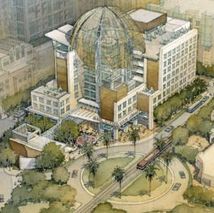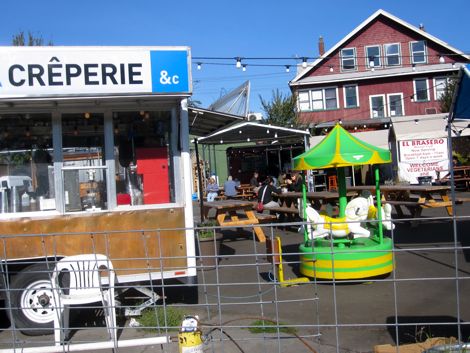|
This article is by A.K. Streeter and can be found at http:www.treehugger.com They are known as 'pods' or 'clusters' - groups of small repurposed trailers and carts with wheels that have infiltrated every major neighborhood in Portland, Oregon. Mexican carts serving soft-shell tacos and bulging burritos were part of the trend's re-ignition. But Portland has taken its food cart pods beyond the norm - there are now more than 200 carts in the city, and they are an institution, and a great part of the local economy. They continue to introducing city dwellers to such fanciful new food trends as Korean-Mexican fusion (Koi Fusion), and have covered over some of the dreaded surface parking lots that so abound. Representing the 35 year citizen effort to build a new main library for the City of San Diego, the new Central Library is designed for LEED Silver certification. It is a nine-story community gather space that incorporates a new downtown charter high school. In this video, Turner Construction is using Building Information Modeling (BIM) to improve efficencies in building San Diego's New Central Library. This model shows different elements of the structural build from when the project was at grade through completion in 2013.  For more information on the new San Diego Central Library, visit the San Diego public Library foundation website. Taken from the San Diego Union Tribune, Nov. 1, 2011 The takeover of parks, plazas and other public spaces by the "Occupy Wall Street" movement is a good thing, said a panel of landscape architects on the future of cities Tuesday at the American Society of Landscape Architects convention meeting in San Diego. "I am so thrilled that we have reclaimed these places as places of protest and how important they are," said Maurice Cox, former mayor of Charlottesville, Va., who now teaches urban design at the University of Virginia. "These places are meant to be where you could petition your government and be heard. You're seeing it across the county. People are trying to find places across the world where they can get their voices heard. That needs to be enabled... The fact that people are shocked that people would have a protest (in a public plaza)!" Martha Schwartz, a landscape architect from Boston now working in London, said Americans are rediscovering the role of public spaces in shaping our democracy."It's the American Spring," she said, comparable to the Arab Spring uprisings in the Middle East. Schwartz was not taking a position on the issues raised by the "Occupy Wall Street" movement but defending the idea that such debates should take place in public places. "The rush to privatizing everything is a loss of civic ethic which in the long-term will make us unsustainable," she said. "We will not be able to compete on the global level. The reason why these are good spaces to have and build and fund and to build into a city is to allow for this kind of civic expression." On another topic, raised by moderator and San Francisco Chronicle columnist John King, is the tendency of cities to copy each other in building iconic landmarks, such as Millennium Park in Chicago or the High Line park on an abandoned elevated railroad in New York City. "I don't think there's any danger with big ideas" imported from place to place, Schwartz said. "The danger is there are not enough ideas. The idea of something iconic for many cities is very important, because they want to put themselves on the global map. Cities are in real competition. The idea that 'iconoism' is bad... These are all real, important places. It's not all or nothing." But Philadelphia landscape architect Laurie Olin said cities like Paris didn't develop great streets, institutions or landmarks for the benefit of visitors. "Historically, most of the things that have produced superb tourism over the long haul have had to do with people building cities for themselves," Olin said. Charles Waldheim, chairman of Harvard's Graduate School of Design, said it isn't an individual project but a broader urban design view that cities should seek. "Every city has a powerful idea," he said. "The mistake is to view these projects as typological. It's community development." However, he noted that some widely heralded projects like the Chicago park and New York High Line originated at the grass roots, not among public officials or planners. Cox said to influence such development decisions, landscape architects need to be "incredibly close" to decision makers and attend community meetings where members of the public argue about priorities and projects. "You have to be in the room when you're discovering some incredible resource is going to be violated," he said. Addressing the economy, the panelists took note that some big projects are on hold and being replaced by what Schwartz termed "meanwhile projects." "They're not forever but they're for now," she said. However, just around the corner, she said, are the implications of climate change, which she likened to the shift in an earlier era. "It will bring massive change around the world," she said. "That makes attention to cities absolutely imperative in the same way the need for a new way of governing ourselves and thinking about people after the feudal ages and coming into the modern age changed the way people thought about design." [email protected]; (619) 293-1286; Facebook: SDUTshowley; Twitter: rmshowley Full article can be found at : http://www.signonsandiego.com/news/2011/nov/01/occupy-protest-sites-good-thing-say-landscape-arch/ |
Design Blogandrew carlos | architect Archives
May 2023
Categories
All
|
Carlos Architects, Inc. All rights reserved. 760.579.3996 [email protected]

 RSS Feed
RSS Feed